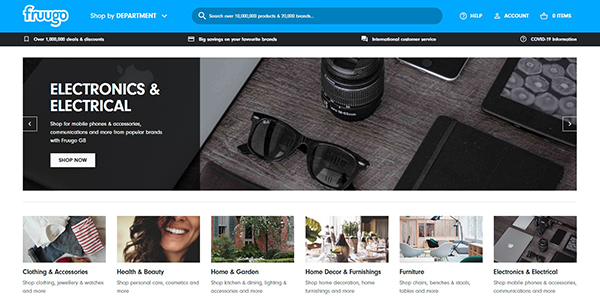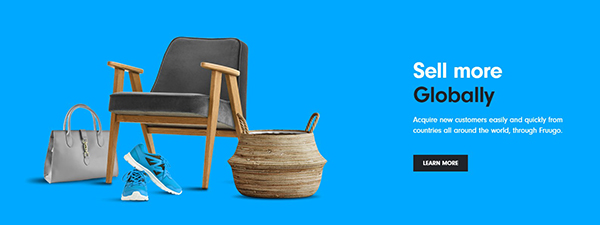March 25, 2021 Guest opinion piece
Fruugo is an online marketplace that connects brands and consumers from all over the world.
Available in more than 40 countries, Fruugo enables both new and experienced cross-border sellers to effectively market products to a truly global audience - and what's more, you only need to pay listing fees when you make a sale.

Fruugo’s offer is different to that offered by other online marketplaces. By specialising in cross-border transactions, merchants gain sales they would not otherwise have got. Fruugo is therefore complementary to existing digital and physical sales channels. And because Fruugo does not sell its own merchandise, brands do not have to worry about the marketplace they join eventually competing with them or copying their assortment.
Brands using Fruugo are offered a different kind of seller experience to what you will have received on other e-commerce marketplaces. Over the past year merchants have been able to benefit from record levels of online sales thanks to support offered by Fruugo, with significant parts of the year seeing sales up by more than 100 per cent YoY.
Fruugo also went further to support its merchants through the pandemic by, waiving joining fees, setting up of a live tracker on VAT policies across Europe and offering one-on-one digital marketing support powered by Fruugo’s wealth of customer data.
Taking the complexity out of global e-commerce
Fruugo is a one-stop-shop for merchants interested in expanding their online sales internationally, regardless of their level of experience with cross-border e-commerce. Brands simply need to supply all their product and marketing information in a single language and a single currency, after which Fruugo takes over the process of translating copy as well as converting currencies. This allows merchants to truly reach consumers in any markets they want to target.
Rather than being a destination marketplace, where customers actively come to the site to search for products they want to purchase, Fruugo’s model relies on consumers being guided to relevant pages because of specific product searches on search engines such as Google. This is highly beneficial for merchants, as they are provided with added exposure they otherwise would not see as one of thousands of retailers on a destination platform.
Reaching a truly global audience
With 85 per cent of its sales being international, Fruugo has unparalleled expertise when it comes to cross-border e-commerce. It hosts localised sites in more than 40 countries, providing access to a host of potential new customers all over the world, including in Scandinavian countries that are often difficult to target.
Merchants are also able to expand their business in the Middle East and throughout Southeast Asia, a diverse market with countless opportunities if executed properly.
A sizeable number of the markets Fruugo is available in are in Europe. As a result, over the past six months the marketplace has spent a lot of effort on assisting brands navigating Brexit, by offering strategic guidance and absorbing many sellers’ new VAT fees, alongside organising seminars on the subject.
That said, Europe was never one market in practice – with tens of languages and many currencies, the logistics of operating in the region is something Fruugo has been assisting with from the start.
The key benefit of using Fruugo is the global reach it has given our business, which has led to substantial sales growth for us. We can now reach consumers in a number of countries across the world in a way that was not feasible previously and target country-specific demands almost immediately. Many consumers also distrust the big marketplaces and prefer using sites like Fruugo to shop, so now we are tapping into those sales too.”
Andrew Gorman, Director at Boolavard
Ahead of the game
Fruugo was founded back in 2008, at which they point they already saw the immense growth potential cross-border selling offers retailers of all shapes and sizes. Since then, it has relocated its headquarters from Finland to the United Kingdom and continuously improved its platform, while growing the number of merchants using the marketplace.
As the COVID-19 induced e-commerce boom took place in 2020, Fruugo was therefore perfectly placed to help merchants through the tumultuous period by growing their online sales.
Fruugo is in a strong position looking ahead at 2021 and beyond too. As sellers look at their sales strategies post-COVID, Fruugo can offer a uniquely simple solution to expanding internationally within a growing number of markets, allowing them to benefit from previously untapped consumer demand around the globe.
Sign up to start selling with Fruugo
With access to over four billion consumers across the globe, signing up with Fruugo is an excellent way to diversify sales and helps ensure a consistent revenue stream.
There are a few basic requirements for joining the platform:
Product GTINs
In 2016, Fruugo made the use of GTINs mandatory for most product categories across the platform to simplify international trading. Given GS1’s strong legacy when it comes to identifying, describing and tracking products as they move through the supply chain, its standards have been the preferred option for many merchants on Fruugo.
GTINs allows customers to find the products they are looking for more easily, increasing the likelihood of relevant searches leading to purchases – something that has contributed to continuous sales growth on Fruugo.
Automated feed
All sellers on Fruugo must be able to supply an automated feed for their store.
Accurate product descriptions
In order to help merchants optimise their marketing on the platform, Fruugo needs to be supplied with product descriptions, including product images without text and logos.
Cost competitiveness
The brands that perform best on Fruugo have competitively priced products, low shipping fees and wide geographical coverage in terms of the markets they ship to. Currently, the product categories that are most in demand include health and beauty, clothing and accessories, watches and jewellery and furniture, although it is important to note that there are also tens of thousands of ‘one offs’ that sell in huge numbers too.
